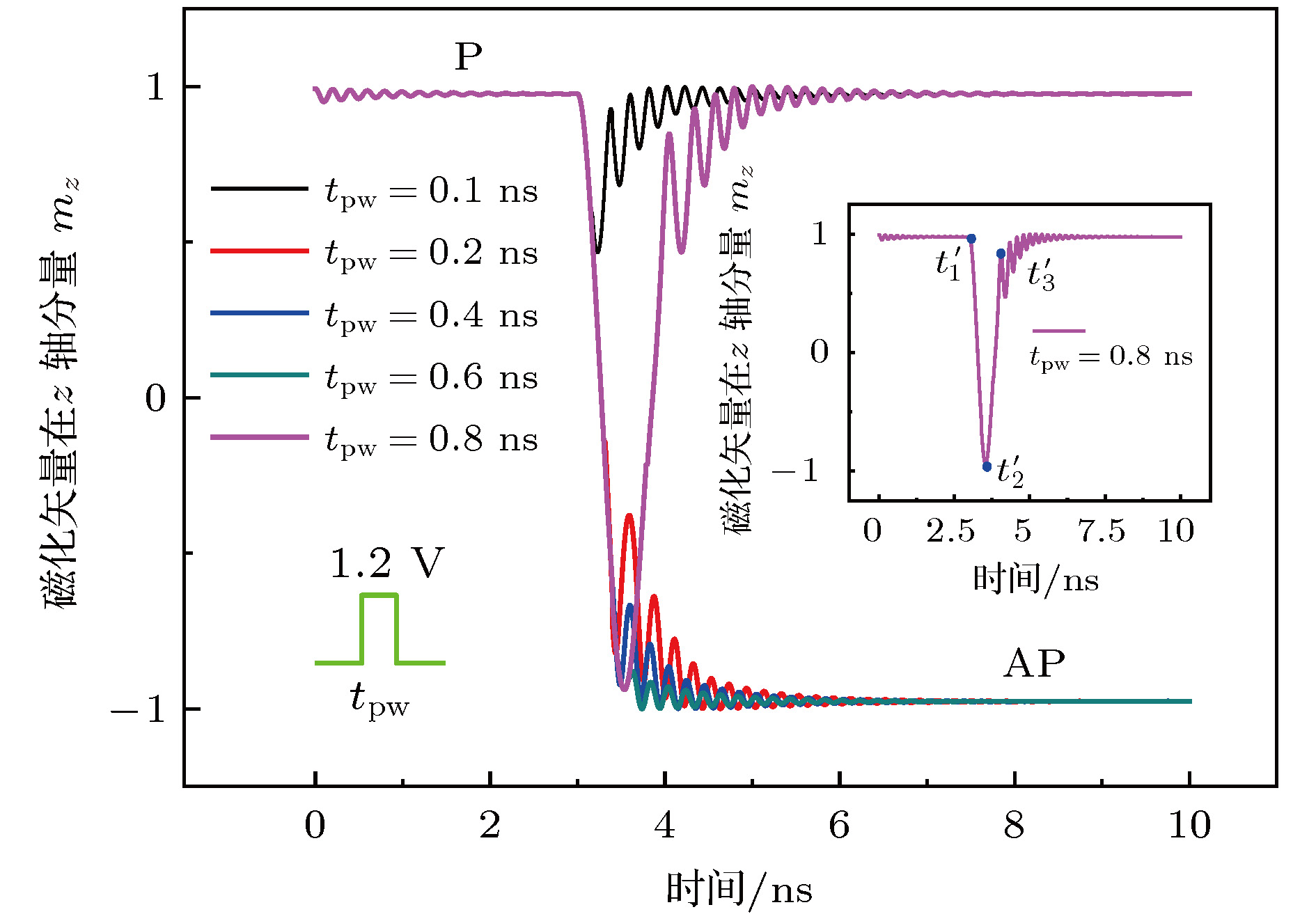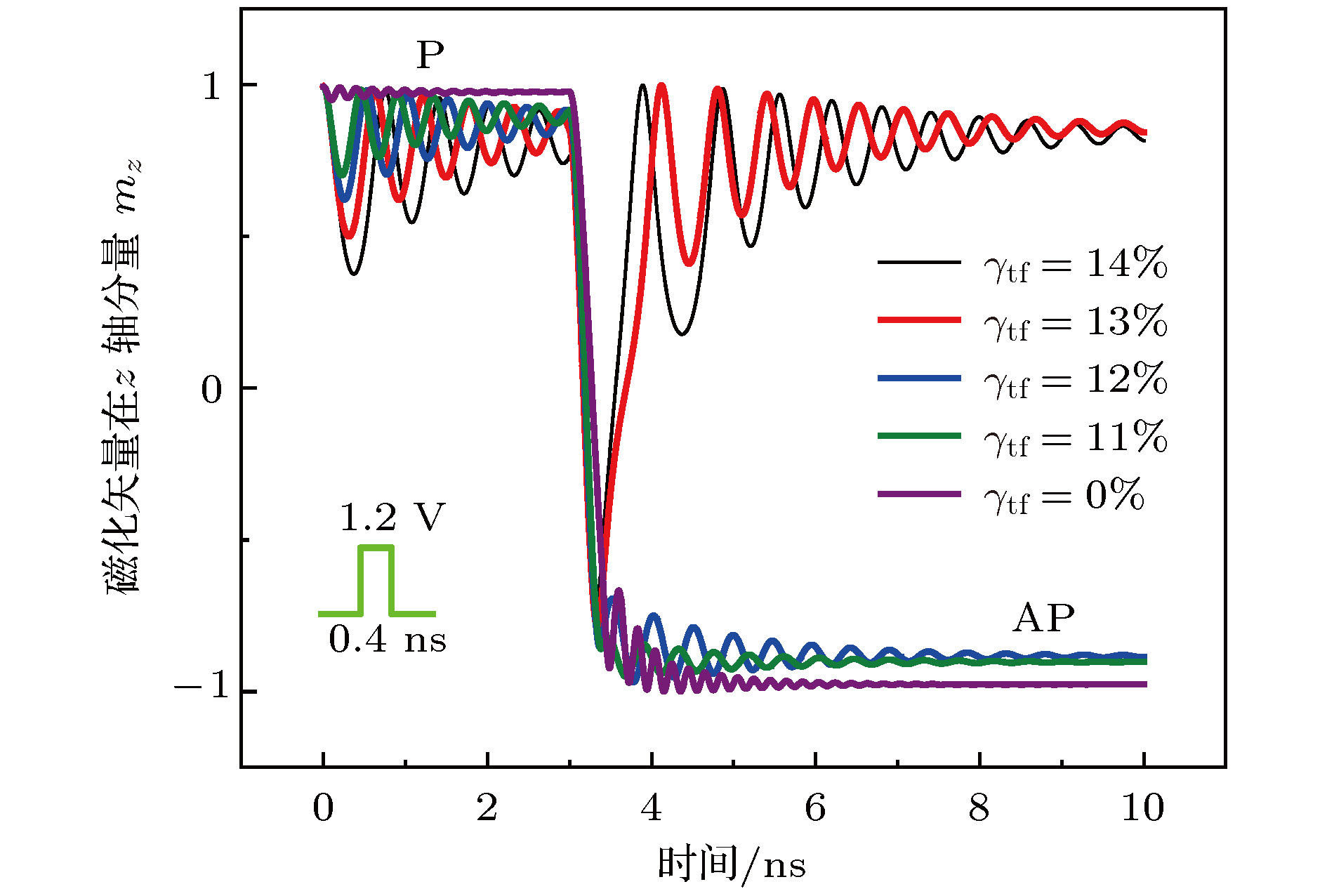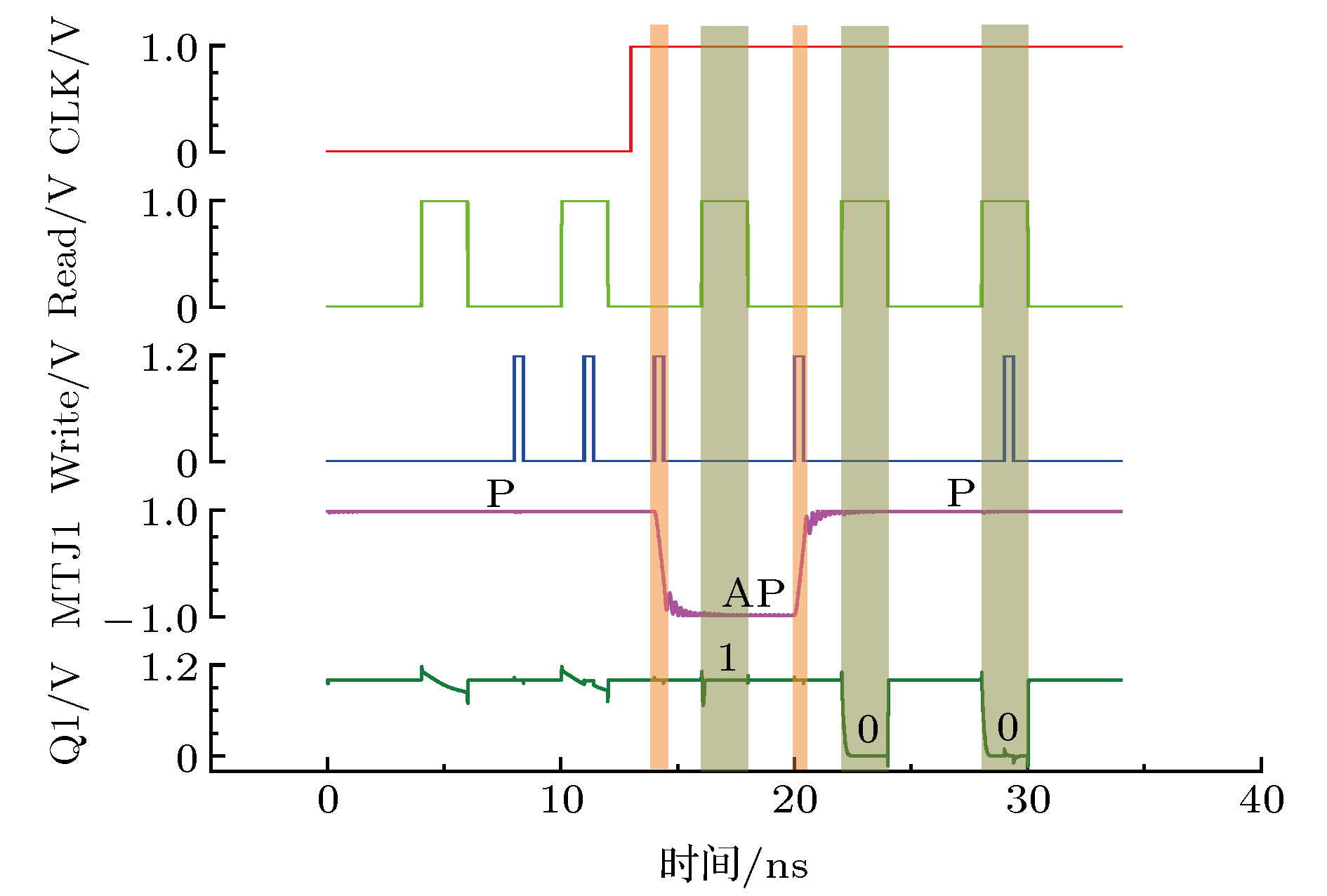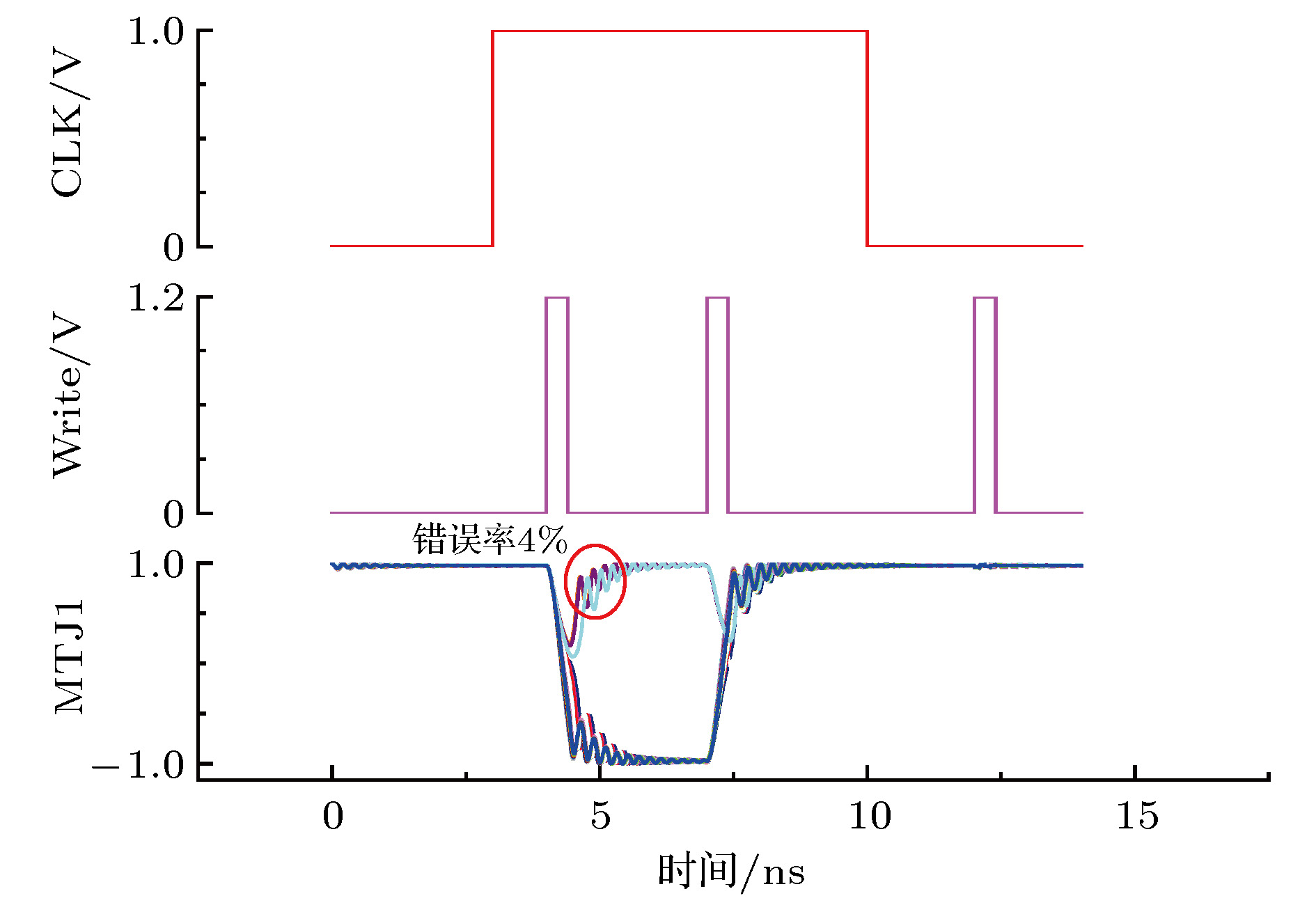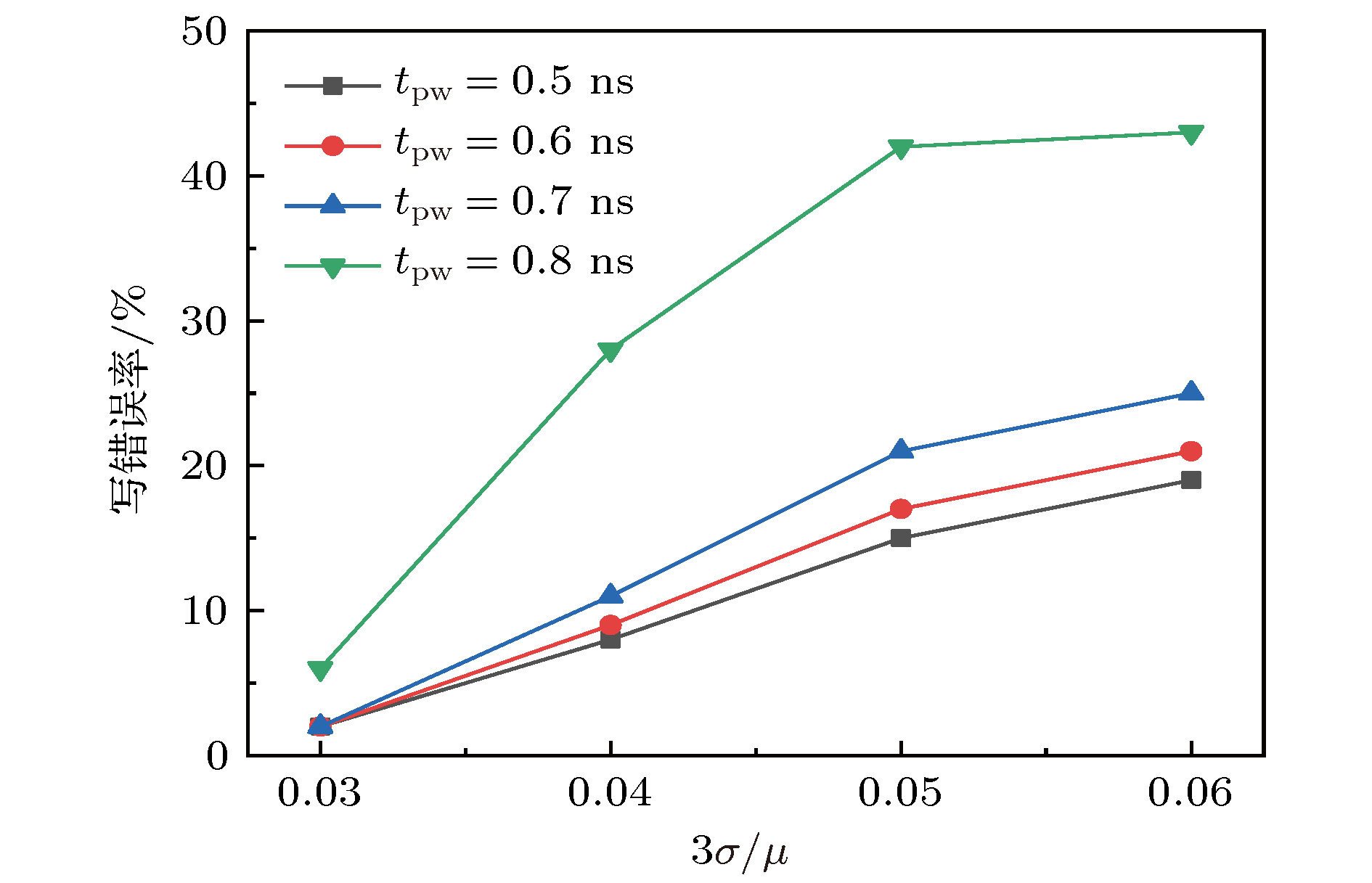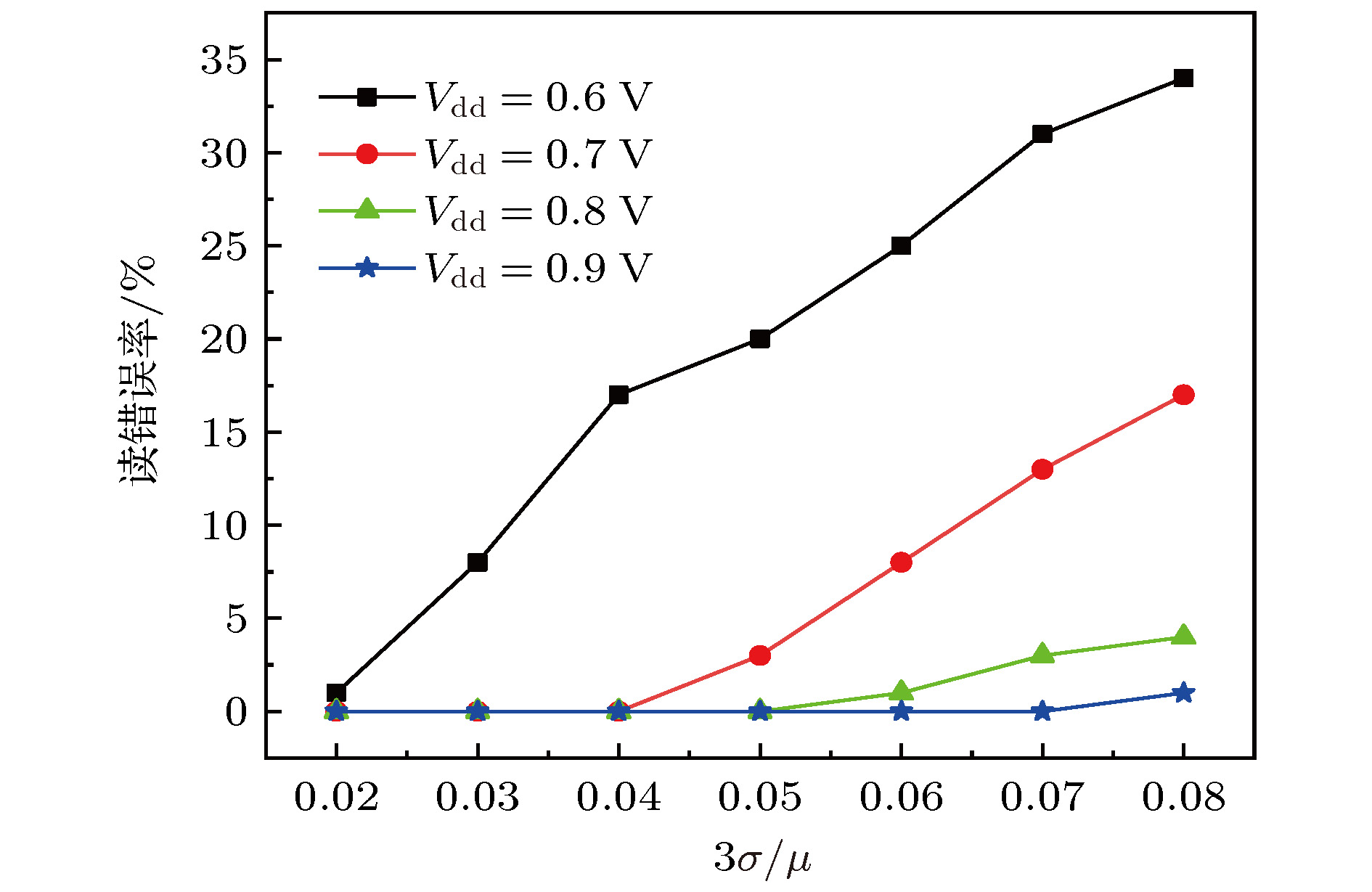-
电压调控磁各向异性磁隧道结(voltage controlled magnetic anisotropy magnetic tunnel junction, VCMA-MTJ)作为磁随机存储器(magnetic random access memory, MRAM)的核心器件, 具有读写速度快、功耗低、与CMOS工艺相兼容等优点, 现已得到国内外学者的广泛关注. 然而随着VCMA-MTJ尺寸不断缩小、MRAM存储容量不断增大, 工艺偏差对MTJ性能的影响变得越来越显著, 甚至会引起VCMA-MTJ电路的读写错误. 本文在充分考虑磁控溅射薄膜生长工艺中自由层厚度偏差(γtf)、氧化势垒层厚度偏差(γtox)以及离子束刻蚀工艺中由侧壁再沉积层引入的刻蚀工艺稳定因子(α)偏差影响的情况下, 给出了基于工艺偏差的VCMA-MTJ电学模型, 并将该模型应用到VCMA-MTJ读写电路中, 研究了工艺偏差对上述电路读写错误率的影响. 结果表明: 当γtf ≥ 13%, γtox ≥ 11%时, VCMA-MTJ将无法实现磁化状态的有效切换; 当α ≤ 0.7时, VCMA-MTJ磁化方向的进动过程变得不稳定. 进一步地, VCMA-MTJ电路的读错误率和写错误率也将随着工艺偏差的增大而增大. 研究表明, 通过增大外加电压(Vb)和减小外加电压脉冲宽度(tpw)可有效降低VCMA-MTJ电路的写错误率, 增大电路的读驱动电压(Vdd)可有效降低VCMA-MTJ电路的读错误率.As one of the primary elements in magnetoresistive random access memory (MRAM), voltage controlled magnetic anisotropy magnetic tunnel junction (VCMA-MTJ) has received wide attention due to its fast read and write speed, low power dissipation, and compatibility with standard CMOS technology. However, with the downscaling of VCMA-MTJ and the increasing of storage density of MRAM, the effect of process deviation on the characteristics of MTJ becomes more and more obvious, which even leads to Read/Write (R/W) error in VCMA-MTJ circuits. Taking into account the depth deviation of the free layer (γtf) and the depth deviation of the oxide barrier layer (γtox) in magnetron sputtering technique as well as the etching process stability factor (α) caused by the sidewall re-deposition layer in the ion beam etching process, the electrical model of VCMA-MTJ with process deviation is presented in the paper. It is shown that the VCMA-MTJ cannot achieve the effective reversal of the magnetization direction when γtf ≥ 13% and γtox ≥ 11%. The precession of magnetization direction in VCMA-MTJ also becomes instable when α ≤ 0.7. Furthermore, the electrical model of VCMA-MTJ with process deviation is also applied to the R/W circuit to study the effect of process deviation on the R/W error in the circuit. Considering the fact that all of γtf, γtox, and α follow Gauss distribution, The 3σ/μ is adopted to represent the process deviation, with using Monte Carlo simulation, where σ is the standard deviation, and μ is the average value. It is shown that the write error of the circuit goes up to 30 % with 3σ/μ of 0.05 and the voltage (Vb) of 1.15 V. At the same time, the read error of the circuit is 20% with 3σ/μ of 0.05 and driving voltage (Vdd) of 0.6 V. Both the read error rate and the write error rate of the VCMA-MTJ circuit increase as process deviation increases. It is found that the write error rate can be effectively reduced by increasing Vb and reducing the voltage pulse width (tpw). The increasing of Vdd is helpful in reducing the read error rate effectively. Our research presents a useful guideline for designing and analyzing the VCMA-MTJ and VCMA-MTJ read/write circuits.
-
Keywords:
- magnetic tunnel junction /
- voltage controlled magnetic anisotropy /
- process deviation /
- read/write circuits
[1] Ikegawa S, Mancoff F B, Janesky J, Aggarwal S 2020 IEEE Trans. Electron Devices 67 1407
 Google Scholar
Google Scholar
[2] Nehra V, Prajapati S, Tankwal P, Zilic Z, Kumar T N, Kaushik B K 2020 IEEE Trans. Magn. 56 1
 Google Scholar
Google Scholar
[3] Sun Y, Gu J, He W, Wang Q, Jing N, Mao Z, Qian W, Jiang L 2019 IEEE Trans. Circuits Syst. II-Express Briefs 66 753
 Google Scholar
Google Scholar
[4] Burr G W, Brightsky M J, Sebastian A, Cheng H, Wu J, Kim S, Sosa N E, Papandreou N, Lung H, Pozidis H, Eleftheriou E, Lam C H 2016 IEEE J. Emerg. Sel. Topics Circuits Syst. 6 146
 Google Scholar
Google Scholar
[5] Wang C Z, Zhang D M, Zhang K L, Zeng L, Wang Y, Hou Z Y, Zhang Y G, Zhao W S 2020 IEEE Trans. Magn. 67 1965
 Google Scholar
Google Scholar
[6] Ryu J W, Kwon K W 2016 IEEE Trans. Magn. 52 1
 Google Scholar
Google Scholar
[7] Prajapati S, Kaushik B K 2018 IEEE Trans. Magn. 55 1
 Google Scholar
Google Scholar
[8] Lee D G, Park S G 2017 IEEE Trans. Magn. 53 1
 Google Scholar
Google Scholar
[9] Khalili A P, Alzate J G, Cai X Q, Ebrahimi F, Hu Q, Wong K, Wang K L 2015 IEEE Trans. Magn. 51 1
 Google Scholar
Google Scholar
[10] Zhang X L, Wang C J, Liu Y W, Zhang Z Z, Jin Q Y, Duan C G 2016 Sci. Rep. 6 18719
 Google Scholar
Google Scholar
[11] Miriyala V P K, Fong X, Liang G 2019 IEEE Trans. Electron Devices. 66 944
 Google Scholar
Google Scholar
[12] Long M, Zeng L, Gao T, Zhang D, Qin X, Zhang Y, Zhao W 2018 IEEE Trans. Nanotechnol. 17 492
 Google Scholar
Google Scholar
[13] Song J, Ahmed I, Zhao Z, Zhang D, Sapatnekar S S, Wang J P, Kim C H 2018 IEEE J. Explor. Solid-State Computat. Dev. Circ. 4 76
 Google Scholar
Google Scholar
[14] Cao K, Li H, Cai W, Wei J, Wang L, Hu Y, Jiang Q, Cui H, Zhao C, Zhao W 2019 IEEE Trans. Magn. 55 1
 Google Scholar
Google Scholar
[15] Jaiswal A, Agrawal A, Roy K 2018 Sci. Rep. 8 1
 Google Scholar
Google Scholar
[16] 张楠, 张保, 杨美音, 蔡凯明, 盛宇, 李予才, 邓永城, 王开友 2017 物理学报 66 5
 Google Scholar
Google Scholar
Zhang N, Zhang B, Yang M Y, Cai K M, Sheng Y, Li Y C, Deng Y C, Wang K Y 2017 Acta Phys. Sin. 66 5
 Google Scholar
Google Scholar
[17] Kang W, Ran Y, Zhang Y, Lü W, Zhao W 2017 IEEE Trans. Nanotechnol. 16 387
 Google Scholar
Google Scholar
[18] Lee H, Lee A, Wang S, Ebrahimi F, Gupta P, Amiri P K, Wang K L 2018 IEEE Trans. Magn. 54 1
 Google Scholar
Google Scholar
[19] Alzate J G, Amiri P K, Upadhyaya P, Cherepov S S, Zhu J, Lewis M, Dorrance R, Katine J A, Langer J, Galatsis K 2012 2012 International Electron Devices Meeting San Francisco, US, December 10–13, 2012 p51
[20] Niranjan M K, Duan C G, Jaswal S S, Tsymbal E Y 2010 Appl. Phys. Lett. 96 222504
 Google Scholar
Google Scholar
[21] Gilbert T L 2004 IEEE Trans. Magn. 40 3443
 Google Scholar
Google Scholar
[22] Ahmed R, Victora R H 2018 Appl. Phys. Lett. 112 182401
 Google Scholar
Google Scholar
[23] Alzate Vinasco J G 2014 Ph. D. Dissertation (California: University of California, Los Angeles
[24] Tsunekawa K, Nagamine Y, Maehara H, Djayaprawira D D, Watanabe N 2007 2006 IEEE International Magnetics Conference San Diego, US, May 8–12, 2006 p855
[25] Rata A D, Braak H, Bürgler D E, Schneider C M 2007 Appl. Phys. Lett. 90 162512
 Google Scholar
Google Scholar
[26] Zhao W, Zhao X, Zhang B, Cao K, Wang L, Kang W, Shi Q, Wang M, Zhang Y, Wang Y 2016 Materials 9 41
 Google Scholar
Google Scholar
[27] Wang Y, Cai H, Naviner L A B, Zhao X X, Zhang Y, Slimani M, Klein J O, Zhao W S 2016 Microelectron. Reliab. 64 26
 Google Scholar
Google Scholar
[28] Ikeda S, Miura K, Yamamoto H, Mizunuma K, Gan H D, Endo M, Kanai S, Hayakawa J, Matsukura F, Ohno H 2010 Nat. Mater. 9 721
 Google Scholar
Google Scholar
[29] Chen E, Schwarz B, Choi C J, Kula W, Wolfman J, Ounadjela K, Geha S 2003 J. Appl. Phys. 93 8379
 Google Scholar
Google Scholar
[30] Ohsawa Y, Shimomura N, Daibou T, Kamiguchi Y, Shirotori S, Inokuchi T, Saida D, Altansargai B, Kato Y, Yoda H 2016 IEEE Trans. Magn. 52 1
 Google Scholar
Google Scholar
[31] Ip V, Huang S, Carnevale S D, Berry I L, Rook K, Lill T B, Paranjpe A P, Cerio F 2017 IEEE Trans. Magn. 53 1
 Google Scholar
Google Scholar
[32] Sugiura K, Takahashi S, Amano M, Kajiyama T, Iwayama M, Asao Y, Shimomura N, Kishi T, Ikegawa S, Yoda H 2009 Jpn. J. Appl. Phys. 48 08HD02
 Google Scholar
Google Scholar
[33] Takahashi S, Kai T, Shimomura N, Ueda T, Amano M, Yoshikawa M, Kitagawa E, Asao Y, Ikegawa S, Kishi T 2006 IEEE Trans. Magn. 42 2745
 Google Scholar
Google Scholar
[34] Xue L, Nistor L, Ahn J, Germain J, Ching C, Balseanu M, Trinh C, Chen H, Hassan S, Pakala M 2014 IEEE Trans. Magn. 50 1
 Google Scholar
Google Scholar
[35] Wang Y, Zhang Y, Deng E Y, Klein J O, Naviner L A B, Zhao W S 2014 Microelectron. Reliab. 54 1774
 Google Scholar
Google Scholar
[36] Aggarwal S, Almasi H, DeHerrera M, Hughes B, Ikegawa S, Janesky J, Lee H K, Lu H, Mancoff F B, Nagel K, Shimon G, Sun J J, Andre T, Alam S M 2019 2019 IEEE International Electron Devices Meeting (IEDM) San Francisco, USA, December 7–11, 2019 p18
[37] Li J, Augustine C, Salahuddin S, Roy K 2008 Proceedings of the 45th annual Design Automation Conference New York, USA, June, 2008 p278
-
表 1 VCMA-MTJ模型参数列表
Table 1. Parameters of the VCMA-MTJ model.
参数 符号 数值 单位 氧化势垒层厚度标准值 tox 1.4 nm 垂直磁各向异性系数 Ki 0.32 mJ/m2 电压调控磁各项异性系数 ξ 60 fJ/(V·m) 自由层厚度标准值 tf 1.1 nm 简化的旋磁比 γ 2.21 × 105 m/(A·s) 磁导率 μ0 1.256 × 10–6 H/m 吉尔伯特阻尼因子 αd 0.05 饱和磁化强度 Ms 0.625 × 106 A/m x, y 轴退磁因子 Nx, y 0.0168 z 轴退磁因子 Nz 0.966 外加磁场在 x 轴分量 Hx 31830 A/m -
[1] Ikegawa S, Mancoff F B, Janesky J, Aggarwal S 2020 IEEE Trans. Electron Devices 67 1407
 Google Scholar
Google Scholar
[2] Nehra V, Prajapati S, Tankwal P, Zilic Z, Kumar T N, Kaushik B K 2020 IEEE Trans. Magn. 56 1
 Google Scholar
Google Scholar
[3] Sun Y, Gu J, He W, Wang Q, Jing N, Mao Z, Qian W, Jiang L 2019 IEEE Trans. Circuits Syst. II-Express Briefs 66 753
 Google Scholar
Google Scholar
[4] Burr G W, Brightsky M J, Sebastian A, Cheng H, Wu J, Kim S, Sosa N E, Papandreou N, Lung H, Pozidis H, Eleftheriou E, Lam C H 2016 IEEE J. Emerg. Sel. Topics Circuits Syst. 6 146
 Google Scholar
Google Scholar
[5] Wang C Z, Zhang D M, Zhang K L, Zeng L, Wang Y, Hou Z Y, Zhang Y G, Zhao W S 2020 IEEE Trans. Magn. 67 1965
 Google Scholar
Google Scholar
[6] Ryu J W, Kwon K W 2016 IEEE Trans. Magn. 52 1
 Google Scholar
Google Scholar
[7] Prajapati S, Kaushik B K 2018 IEEE Trans. Magn. 55 1
 Google Scholar
Google Scholar
[8] Lee D G, Park S G 2017 IEEE Trans. Magn. 53 1
 Google Scholar
Google Scholar
[9] Khalili A P, Alzate J G, Cai X Q, Ebrahimi F, Hu Q, Wong K, Wang K L 2015 IEEE Trans. Magn. 51 1
 Google Scholar
Google Scholar
[10] Zhang X L, Wang C J, Liu Y W, Zhang Z Z, Jin Q Y, Duan C G 2016 Sci. Rep. 6 18719
 Google Scholar
Google Scholar
[11] Miriyala V P K, Fong X, Liang G 2019 IEEE Trans. Electron Devices. 66 944
 Google Scholar
Google Scholar
[12] Long M, Zeng L, Gao T, Zhang D, Qin X, Zhang Y, Zhao W 2018 IEEE Trans. Nanotechnol. 17 492
 Google Scholar
Google Scholar
[13] Song J, Ahmed I, Zhao Z, Zhang D, Sapatnekar S S, Wang J P, Kim C H 2018 IEEE J. Explor. Solid-State Computat. Dev. Circ. 4 76
 Google Scholar
Google Scholar
[14] Cao K, Li H, Cai W, Wei J, Wang L, Hu Y, Jiang Q, Cui H, Zhao C, Zhao W 2019 IEEE Trans. Magn. 55 1
 Google Scholar
Google Scholar
[15] Jaiswal A, Agrawal A, Roy K 2018 Sci. Rep. 8 1
 Google Scholar
Google Scholar
[16] 张楠, 张保, 杨美音, 蔡凯明, 盛宇, 李予才, 邓永城, 王开友 2017 物理学报 66 5
 Google Scholar
Google Scholar
Zhang N, Zhang B, Yang M Y, Cai K M, Sheng Y, Li Y C, Deng Y C, Wang K Y 2017 Acta Phys. Sin. 66 5
 Google Scholar
Google Scholar
[17] Kang W, Ran Y, Zhang Y, Lü W, Zhao W 2017 IEEE Trans. Nanotechnol. 16 387
 Google Scholar
Google Scholar
[18] Lee H, Lee A, Wang S, Ebrahimi F, Gupta P, Amiri P K, Wang K L 2018 IEEE Trans. Magn. 54 1
 Google Scholar
Google Scholar
[19] Alzate J G, Amiri P K, Upadhyaya P, Cherepov S S, Zhu J, Lewis M, Dorrance R, Katine J A, Langer J, Galatsis K 2012 2012 International Electron Devices Meeting San Francisco, US, December 10–13, 2012 p51
[20] Niranjan M K, Duan C G, Jaswal S S, Tsymbal E Y 2010 Appl. Phys. Lett. 96 222504
 Google Scholar
Google Scholar
[21] Gilbert T L 2004 IEEE Trans. Magn. 40 3443
 Google Scholar
Google Scholar
[22] Ahmed R, Victora R H 2018 Appl. Phys. Lett. 112 182401
 Google Scholar
Google Scholar
[23] Alzate Vinasco J G 2014 Ph. D. Dissertation (California: University of California, Los Angeles
[24] Tsunekawa K, Nagamine Y, Maehara H, Djayaprawira D D, Watanabe N 2007 2006 IEEE International Magnetics Conference San Diego, US, May 8–12, 2006 p855
[25] Rata A D, Braak H, Bürgler D E, Schneider C M 2007 Appl. Phys. Lett. 90 162512
 Google Scholar
Google Scholar
[26] Zhao W, Zhao X, Zhang B, Cao K, Wang L, Kang W, Shi Q, Wang M, Zhang Y, Wang Y 2016 Materials 9 41
 Google Scholar
Google Scholar
[27] Wang Y, Cai H, Naviner L A B, Zhao X X, Zhang Y, Slimani M, Klein J O, Zhao W S 2016 Microelectron. Reliab. 64 26
 Google Scholar
Google Scholar
[28] Ikeda S, Miura K, Yamamoto H, Mizunuma K, Gan H D, Endo M, Kanai S, Hayakawa J, Matsukura F, Ohno H 2010 Nat. Mater. 9 721
 Google Scholar
Google Scholar
[29] Chen E, Schwarz B, Choi C J, Kula W, Wolfman J, Ounadjela K, Geha S 2003 J. Appl. Phys. 93 8379
 Google Scholar
Google Scholar
[30] Ohsawa Y, Shimomura N, Daibou T, Kamiguchi Y, Shirotori S, Inokuchi T, Saida D, Altansargai B, Kato Y, Yoda H 2016 IEEE Trans. Magn. 52 1
 Google Scholar
Google Scholar
[31] Ip V, Huang S, Carnevale S D, Berry I L, Rook K, Lill T B, Paranjpe A P, Cerio F 2017 IEEE Trans. Magn. 53 1
 Google Scholar
Google Scholar
[32] Sugiura K, Takahashi S, Amano M, Kajiyama T, Iwayama M, Asao Y, Shimomura N, Kishi T, Ikegawa S, Yoda H 2009 Jpn. J. Appl. Phys. 48 08HD02
 Google Scholar
Google Scholar
[33] Takahashi S, Kai T, Shimomura N, Ueda T, Amano M, Yoshikawa M, Kitagawa E, Asao Y, Ikegawa S, Kishi T 2006 IEEE Trans. Magn. 42 2745
 Google Scholar
Google Scholar
[34] Xue L, Nistor L, Ahn J, Germain J, Ching C, Balseanu M, Trinh C, Chen H, Hassan S, Pakala M 2014 IEEE Trans. Magn. 50 1
 Google Scholar
Google Scholar
[35] Wang Y, Zhang Y, Deng E Y, Klein J O, Naviner L A B, Zhao W S 2014 Microelectron. Reliab. 54 1774
 Google Scholar
Google Scholar
[36] Aggarwal S, Almasi H, DeHerrera M, Hughes B, Ikegawa S, Janesky J, Lee H K, Lu H, Mancoff F B, Nagel K, Shimon G, Sun J J, Andre T, Alam S M 2019 2019 IEEE International Electron Devices Meeting (IEDM) San Francisco, USA, December 7–11, 2019 p18
[37] Li J, Augustine C, Salahuddin S, Roy K 2008 Proceedings of the 45th annual Design Automation Conference New York, USA, June, 2008 p278
计量
- 文章访问数: 11657
- PDF下载量: 175
- 被引次数: 0














 下载:
下载:



